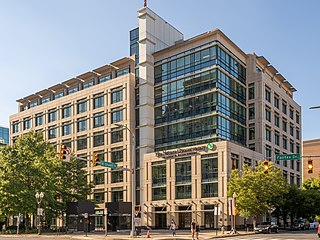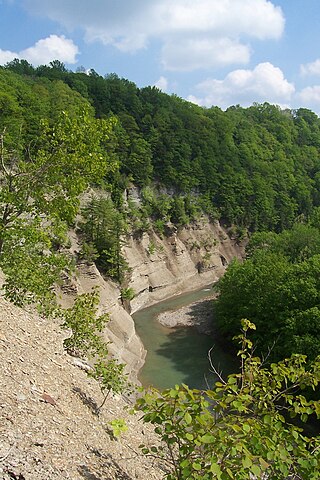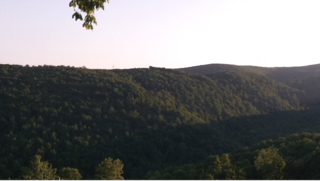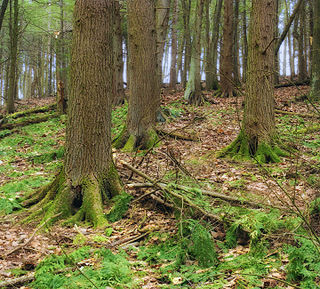
The Old-Growth Forest Network is an American 501(c)(3) non-profit organization whose mission is to protect old-growth forests from logging by identifying them throughout the United States. [1]

The Old-Growth Forest Network is an American 501(c)(3) non-profit organization whose mission is to protect old-growth forests from logging by identifying them throughout the United States. [1]
The Old-Growth Forest Network's vision is a national network of forests where people are able to experience the beauty and integrity of nature. To achieve its vision, the organization strives to create a network of forests across the U.S.—with one in each county—that are not logged and are open to visitors. In the Eastern United States, more than 99 percent of old-growth forests have been cleared for agricultural or developmental purposes, or have been replaced by second-growth forests. [2] The organization's goal is to ensure that some forests are set aside and protected, allowing them to recover their old-growth characteristics. These "future old-growth forests" will provide opportunities for future generations across the country to experience native forests in their mature diversity and complexity.
The Old-Growth Forest Network was founded by Joan Maloof, Salisbury University, Maryland, now Executive Director of the organization. She spends her time lecturing, writing, visiting forests, assisting private landowners, and supporting local groups trying to protect community forests from development. [3] The work of the Old-Growth Forest Network is also supported by staff and volunteers, including County Coordinators who act as liaisons to the managers of the dedicated forests in the network. [4] [5]
Maloof began as a scientist studying the natural workings of the planet—the systems that enable the trees and flowers and animals to subsist on their own with no help from humans. When she looked for natural places to study, she found that almost everything had been affected by humans. She also became aware that the oldest forests—some of the most natural and biologically diverse places on earth—were being logged and converted into managed forests—monoculture tree farms. Maloof was not opposed to harvesting trees for board and fiber, but as an ecologist, she knew that sacrificing biodiversity came hand in hand with not only sacrificing beauty but also toppling the network that keeps the balance of the planet.
Maloof realized that as a scientist she could do little to ensure that at least some of the forests would be left alone, but that as a writer she could share what other scientists had learned about the importance of ancient forests. She wrote Teaching the Trees: Lessons from the Forest. [6] The first chapter describes visiting an eastern old-growth forest, a forest that had never been logged. Her readers, few of whom had ever witnessed an old-growth forest, wanted to know how they could visit one. There were a few left, but very little information existed about how to find them. That led to a second book: Among the Ancients: Adventures in the Eastern Old-Growth Forests, [7] reflections on one old forest in each of the twenty-six Eastern states—with directions. [8] Maloof went on to author two more books: Nature's Temples: The Complex World of Old-Growth Forests, [9] and The Living Forest: A Visual Journey Into the Heart of the Woods, [10] a coffee-table book featuring the photography of Robert Llewellyn.
In her journeys to these forests, and through the forestry literature, Maloof learned that very few original forests have not been logged or otherwise disturbed—less than 1% remains in the East, and 5% in the West. Thus began Maloof's transition from writer to founder of an organization that would identify and help protect one forest in each county of the US where forests could grow and let people know where they were located. Her plan was to help stop the destruction of what old-growth remained, help some forests recover, and enable more Americans to experience an old forest.
In 2011 she left her university position and started working full-time to establish the Old-Growth Forest Network. With the help of her board, Maloof started building the network and educating others about it. In that first year, twenty forests were formally added to the Network and 600 supporters signed up. Maloof gave twenty-three lectures—including talks at Longwood Gardens, the US Botanical Garden, Cornell University and Penn State University. [11] [12]
As of July 15, 2021, the Network had 138 inductees in 25 states, toward the goal of having at least one forest in every county in the United States that can sustain a forest—estimated to be 2,370 counties. [13] As of March 22, 2023, the Network had 189 inductee forests in 32 states. [1]
For the network to be within reach of all Americans, the organization intends to identify one forest that will be left forever wild within each county where forests naturally grow. Of the 3,140 counties in the US, it is estimated that about 75%, or 2,370 will support forests. Many of these counties already contain public forests so only a single one would need to be chosen and officially recognized as part of the network. In many counties it will be already protected Federal land which becomes recognized in the network, such as a National Forest or Fish and Wildlife land. In other places, it may be a State Forest that is recognized. In some counties that have no State or Federal lands, the county or city itself may have some property that could become part of the network. The next level of landowners to be considered for voluntarily joining the network are likely to be nonprofit organizations such as land trusts or The Nature Conservancy. In the less common situations where there are no public lands and no nonprofit organization lands which can be included in the network, a county may appeal to a private donor or apply for federal grant funds, perhaps with the assistance of an organization such as The Conservation Fund.
The Old-Growth Forest Network's strategy is to identify candidate forests, ensure that they are publicly accessible and protected forever from logging, and recognize them as part of the network. Once dedicated, the forests are listed and publicized on the network's website. The organization believes that building the Network in this way will take very little financial investment, and that the preservation of over two thousand undisturbed, accessible forests will have a positive effect on both the humans and the wildlife in the U.S.
Local activists contact the Old-Growth Forest Network to help protect community forests threatened with development. The organization advocates for forest preservation and assists local protection efforts where possible. Community forests that may not be as large, ecologically diverse, or as stringently protected can be inducted into the Old-Growth Forest Network's Community Forest program.
Many of the oldest forests in the United States are privately owned. The organization advises private landowners about their forests and helps them realize their preservation goals. Private forest owners who commit to protecting their land in perpetuity through mechanisms such as a "Forever Wild" conservation easement (meaning it will never be logged) [14] may also receive recognition by the Old-Growth Forest Network's Private Forest designation.

In the United States, national forest is a classification of protected and managed federal lands that are largely forest and woodland areas. They are owned collectively by the American people through the federal government and managed by the United States Forest Service, a division of the United States Department of Agriculture. The U.S. Forest Service is also a forestry research organization which provides financial assistance to state and local forestry industry. There are 154 national forests in the United States.
The Limpinwood Nature Reserve is a protected nature reserve that is located on the Northern Rivers region of New South Wales, in eastern Australia. The reserve was gazetted in April 1963 with additions made in 1967, over former fauna and crown reserves, and further additions were made in 1988 to make the reserve to its current area of 2,646 hectares. The reserve is situated north-west of the rural locality of Limpinwood, and north of Tyalgum and defines part of the state border between New South Wales and Queensland.

The longleaf pine is a pine species native to the Southeastern United States, found along the coastal plain from East Texas to southern Virginia, extending into northern and central Florida. In this area it is also known as "yellow pine" or "long leaf yellow pine", although it is properly just one out of a number of species termed yellow pine. It reaches a height of 30–35 m (98–115 ft) and a diameter of 0.7 m (28 in). In the past, before extensive logging, they reportedly grew to 47 m (154 ft) with a diameter of 1.2 m (47 in). The tree is a cultural symbol of the Southern United States, being the official state tree of Alabama. Contrary to popular belief, this particular species of pine is not officially the state tree of North Carolina.

The Nature Conservancy (TNC) is a global environmental organization headquartered in Arlington, Virginia. As of 2021, it works via affiliates or branches in 79 countries and territories, as well as across every state in the US.

Congaree National Park is a 26,692.6-acre American national park in central South Carolina, 18 miles southeast of the state capital, Columbia. The park preserves the largest tract of old growth bottomland hardwood forest left in the United States. The lush trees growing in its floodplain forest are some of the tallest in the eastern United States, forming one of the highest temperate deciduous forest canopies remaining in the world. The Congaree River flows through the park. About 15,000 acres are designated as a wilderness area.

The Allegheny National Forest is a National Forest in Northwestern Pennsylvania, about 100 miles northeast of Pittsburgh. The forest covers 513,175 acres of land. Within the forest is Kinzua Dam, which impounds the Allegheny River to form Allegheny Reservoir. The administrative headquarters for the Allegheny National Forest is in Warren. The Allegheny National Forest has two ranger stations, one in Marienville, Forest County, and the other in Bradford, McKean County.

An old-growth forest, sometimes synonymous with primary forest, virgin forest, late seral forest, primeval forest, first-growth forest, or mature forest—is a forest that has attained great age without significant disturbance, and thereby exhibits unique ecological features, and might be classified as a climax community. The Food and Agriculture Organization of the United Nations defines primary forests as naturally regenerated forests of native tree species where there are no clearly visible indications of human activity and the ecological processes are not significantly disturbed. Barely one-third of the world's forests are primary forests. Old-growth features include diverse tree-related structures that provide diverse wildlife habitats that increases the biodiversity of the forested ecosystem. Virgin or first-growth forests are old-growth forests that have never been logged. The concept of diverse tree structure includes multi-layered canopies and canopy gaps, greatly varying tree heights and diameters, and diverse tree species and classes and sizes of woody debris.

Hartwick Pines State Park is a public recreation area covering 9,762 acres (3,951 ha) in Crawford County near Grayling and Interstate 75 on the Lower Peninsula of the U.S. state of Michigan. The state park contains an old-growth forest of white pines and red pines, known as the Hartwick Pines. It is claimed by the Michigan Department of Natural resources that this old growth area, along with the Red Pine Natural Area Preserve in Roscommon County resembles the appearance of all Northern Michigan prior to the logging era. These areas do, however, lack the reoccurring low intensity fires which once occurred throughout northern Michigan, impacting regeneration of red pine and eastern hemlock, as well as leading to an increased content of hardwood species such as sugar maple and beech.

Salt Springs State Park is a Pennsylvania state park in Franklin Township, Susquehanna County, Pennsylvania, in the United States. The park is home to massive hemlock trees that are over 500 years old and are among the largest trees in all of Pennsylvania. The Fall Brook Natural Area within the park is recognized as a part of the Old-Growth Forest Network. The park also features a gorge with three waterfalls on Fall Brook. Salt Springs State Park is 7 miles (11 km) north of Montrose, just off Pennsylvania Route 29. The park is the only state park in Pennsylvania that is managed by a non-profit organization, the Friends of Salt Springs Park. The state owns 405 acres (164 ha) of land and the Friends own an additional 437 acres (177 ha) bringing the total amount of protected land to 842 acres (341 ha).
The following outline is provided as an overview of and guide to forestry:

Zoar Valley is an area of deep gorges along the Main and South branches of Cattaraugus Creek in western New York, United States. The valley is located along the border of Erie County and Cattaraugus County, roughly between the villages of Gowanda to the west and Springville to the east.

The Ancient Forest Alliance is a grassroots environmental organization in British Columbia, Canada. It was founded in January 2010, and is dedicated to protecting British Columbia's old-growth forests in areas where they are scarce, and ensuring sustainable forestry jobs in that province.

Quebec Run Wild Area is a 7,441-acre section of Forbes State Forest located in Fayette County, Pennsylvania just north of the Mason–Dixon line and the Pennsylvania border with West Virginia. Situated on the eastern slope of Chestnut Ridge, one of the westernmost ridges in the Appalachian Mountain Range, Quebec Run is heavily forested and contains several miles of maintained, interconnected trail. As is the case with all Pennsylvania state forest wild areas, no development of a permanent nature is permitted “in order to retain the undeveloped character of the area.” Quebec Run is the largest wild area without a road in southwestern Pennsylvania and serves as a destination for various outdoor activities including hiking, mountain biking, and cross-country skiing.
The Mann River Nature Reserve is a protected nature reserve that is located on the eastern edge of the Great Dividing Range on the Northern Tablelands in the New England region of New South Wales, in eastern Australia. The 7,128-hectare (17,610-acre) reserve is situated approximately 57 kilometres (35 mi) east of the town of Glen Innes, some 145 kilometres (90 mi) west of Grafton, and approximately 155 kilometres (96 mi) north-east of Armidale. The reserve is located to the south of the Gwydir Highway on the Old Grafton Road. The Mann River bisects the reserve.

The Jakey Hollow Natural Area is a natural area in Jakey Hollow in Columbia County, Pennsylvania, in the United States. The natural area has an area of 59 acres. A hiking trail known as the Ward Crawford Trail is in the area and hunting is also permitted there. Part of the natural area is old-growth forest and recognized by the Old-Growth Forest Network. Some logging was historically done in portions of Jakey Hollow. The area was purchased by Ward Crawford and his brother in the 1950s. They sold it to the Pennsylvania Department of Conservation and Natural Resources in 1990.

Robert Llewellyn is an American photographer whose images have served as the basis for numerous books and exhibits. He studied engineering science at the University of Virginia, and photography with Imogen Cunningham in the 1960s. He married Barbara Reading Grant in 1981 and they live together in Earlysville, Virginia.

Joan Maloof is an American environmental activist and author. She founded the Old-Growth Forest Network in 2012.